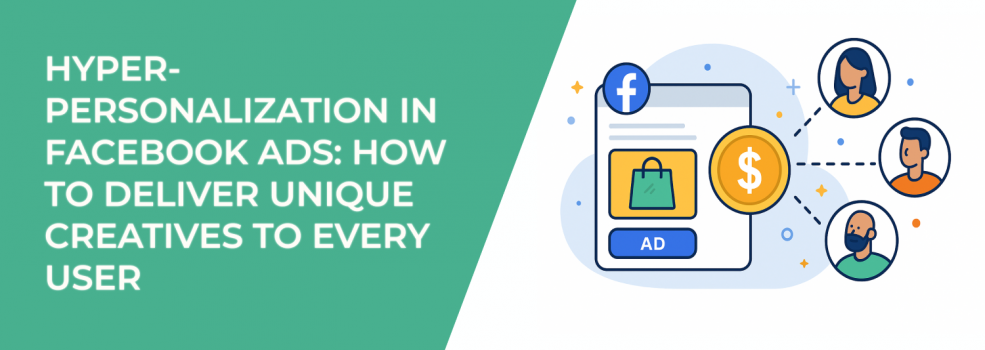If you want to stand out in today’s crowded digital world, you need to give people exactly what they want and that's where hyper-personalization in Facebook ads comes in. People expect ads to be tailored to their interests, behaviors, and preferences. So, how can you make sure your ads stand out and truly connect with your audience? Let’s break it down and explore how you can create Facebook ads that feel personal, relevant, and unique to every user.
What Is Hyper-Personalization in Facebook Ads?
Hyper-personalization is all about going deeper than basic demographics like age or location. Instead of just showing the same ad to everyone, you create different versions of the ad based on things like how the user interacts with your brand, what they've looked at in the past, and where they are in their customer journey. The goal is to make each person feel like the ad was created just for them.
Why Should You Care About Hyper-Personalization?
In a world where consumers are overwhelmed with choices, personalization can make your ads stand out. With Facebook’s powerful tools, you can target your audience based on interests, online behavior, and even past purchases. This means you can reach the right people with the right message at the right time.
The benefits are huge:
-
Better Engagement: People are more likely to interact with ads that feel relevant to them.
-
Higher Conversion Rates: When your ads match people’s needs, they’re more likely to take action.
-
Improved ROI: The more targeted and personalized your ads are, the better your return on investment.
Tips for Creating Hyper-Personalized Facebook Ads
So, how can you get started with hyper-personalization? Here are some simple tips that will help you create ads that feel unique and engaging to each person.
1. Use Dynamic Creative
Facebook’s dynamic creative feature allows you to upload different images, videos, headlines, and descriptions, and Facebook will automatically mix and match these elements to show the best-performing combination to each person.
For example, if you’re running an e-commerce ad for shoes, you can upload images of different styles (e.g., running shoes, sandals, boots) and headlines like “Shop the Latest Styles” or “Perfect Fit for Your Next Run.” Facebook will show users the combinations they’re most likely to engage with.
Tip: Upload multiple images (product shots, lifestyle images, etc.) and try different headlines. Facebook will handle the rest, showing users the best match. For more on creative testing, check out The Best Facebook Ad Formats.
2. Segment Your Audience
Audience segmentation is key to personalizing your ads. Instead of showing the same ad to everyone, you can break your audience into smaller groups based on factors like:
-
Past purchases: Show people who’ve already bought from you ads for complementary products.
-
Interests: If someone loves fitness, show them ads for workout gear or healthy snacks.
-
Location: Tailor your ads to different geographic locations to make them more relevant.
-
Behavior: Target users based on their past interactions with your brand, such as whether they clicked on your website or watched a video.
For instance, if someone clicked on a product page for a winter jacket but didn’t purchase, you can show them a retargeted ad with that same jacket or a similar style, offering a discount to encourage them to complete the purchase.
Tip: Always test different segments to see which group responds the best to your ads. Learn more about segmenting Facebook audiences by category.
3. Retargeting Is Your Best Friend
Retargeting is showing ads to people who have already interacted with your brand. Maybe they visited your website, liked your Facebook page, or watched one of your videos. These people are already familiar with your brand, so showing them personalized ads can nudge them closer to a purchase.
Let’s say you run an online store and someone adds a product to their cart but doesn't check out. You can create a retargeting ad showing that specific product, reminding them to complete the purchase with a limited-time discount.
Use Facebook's retargeting options to reach people who:
-
Added items to their cart but didn’t buy.
-
Viewed specific products on your site.
-
Watched videos or engaged with your posts.
Check out Retargeting: What Marketers Need to Know in 2025 for more insights.
4. Show Personalized Product Recommendations
Facebook makes it easy to show personalized product recommendations through dynamic ads. If someone visited your online store and looked at a particular pair of shoes, you can show them ads for those shoes or similar products that might interest them. This is a great way to remind them about their interest and boost conversions.
For example, if someone browsed your website for running shoes, you could show them an ad featuring a running shoe they didn’t buy, or even offer a deal on running accessories like socks or water bottles.
Tip: Set up a product catalog on Facebook and use it to show dynamic ads that reflect each user’s past activity. Want more on product recommendations? Read about How to Combine Dynamic Ads with Retargeting for E-Commerce Success.
5. Incorporate User-Generated Content (UGC)
People trust reviews, photos, and videos from other customers more than traditional ads. Featuring user-generated content in your ads is a great way to build trust and create a more personal connection with your audience. If a customer shares a photo of themselves using your product, you can use that photo in your ad to show potential buyers that real people are using and loving your product.
Tip: Reach out to your customers and ask them for photos or reviews. Feature this content in your Facebook ads to make them feel more authentic and relatable. Check out How to Use User-Generated Content in Your Facebook Ads for Authentic Engagement.
6. Refine Your Targeting with Facebook’s Advanced Features
Facebook provides many tools to help you refine your targeting. For example:
-
Custom Audiences: Target people who have already interacted with your brand.
-
Lookalike Audiences: Find new customers who share similar behaviors and interests to your best existing customers.
For example, if you have a group of loyal customers, you can create a Lookalike Audience to target people who are likely to be interested in your product, based on similarities to your existing buyers.
Tip: Regularly refine your audience to make sure you're reaching the people most likely to engage with your ads. Want to learn more? Check out Mastering Facebook Lookalike Audiences for Higher ROI.
How to Measure the Success of Your Hyper-Personalized Ads
Once your hyper-personalized ads are up and running, it’s crucial to track their performance to see if they’re really driving results. Some key metrics to focus on include:
-
Click-Through Rate (CTR): This tells you how often people are clicking on your ad.
-
Conversion Rate: How many people take the desired action, like purchasing a product or signing up for a newsletter.
-
Cost Per Acquisition (CPA): The amount you spend to acquire a customer. Lower CPA means better efficiency.
-
Return on Ad Spend (ROAS): This measures how much revenue you make from your ads compared to what you spent.
The goal is to tweak your campaigns based on these metrics to continually improve your ROI.
Wrapping It Up
Hyper-personalization is more than just a buzzword — it’s a powerful strategy that can make your Facebook ads feel more relevant and engaging. By tailoring your creatives to individual users’ preferences, behaviors, and interests, you can significantly improve your campaign performance and drive better results.
So, are you ready to take your Facebook ads to the next level with hyper-personalization? Start testing dynamic creatives, refining your audience segments, and using retargeting to see just how powerful personalized ads can be.

